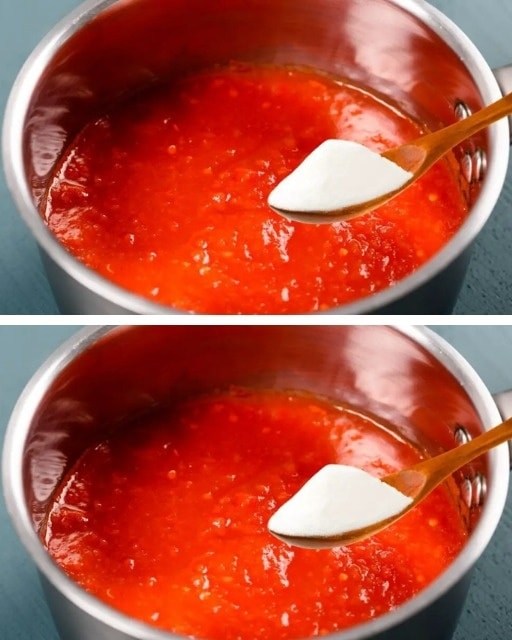Delving into the realm of homemade tomato sauce, every chef seeks to elevate its taste and texture to perfection. A culinary technique that has recently garnered attention is the addition of baking soda to tomato sauce.
Despite its unexpected nature, this common baking ingredient holds the key to a remarkable transformation in the final outcome of your tomato sauce. In this discourse, we shall unravel why incorporating baking soda stands as the optimal choice to enrich flavors and achieve a seamlessly balanced tomato sauce.
Enhance Your Sauce with Baking Soda:
Introducing baking soda into tomato sauce might seem unconventional, yet its effects prove strikingly beneficial in refining flavor, balancing acidity, enhancing color, softening texture, and expediting cooking time:
Neutralizes acidity:
A primary advantage of incorporating baking soda is its ability to neutralize the inherent acidity of tomatoes. Ripe tomatoes often boast a high acidity level, contributing to an overly acidic and discordant tomato sauce. By judiciously adding baking soda, acidity is mitigated without compromising the distinctive tomato flavor, resulting in a smoother and more harmonious sauce.
Improves color:
Another boon of baking soda lies in its capacity to enhance the color of tomato sauce. Occasionally, tomatoes exhibit a lackluster or slightly brownish tint, detracting from the sauce’s visual appeal. Through a chemical reaction, baking soda imparts a vibrant red hue to the tomatoes, yielding a more enticing and appetizing tomato sauce.
Softens the texture:
Baking soda exerts a favorable influence on the texture of tomato sauce by tenderizing its fibers. By diminishing acidity, baking soda aids in breaking down the resilient fibers within tomatoes, culminating in a velvety, less fibrous tomato sauce. This transformation is particularly advantageous for those preferring a smoother, silkier sauce, ideal for embellishing pizzas, pastas, or serving as a base for various preparations.
Saves cooking time:
The incorporation of baking soda expedites the cooking process of tomato sauce. The chemical reaction catalyzed by baking soda hastens the breakdown of cellular bonds and accelerates ingredient softening. Consequently, the requisite cooking duration for achieving a well-cooked tomato sauce with intensified flavor is diminished—a boon for busy kitchen endeavors.
Guidance and Recommendations:
When integrating baking soda into your tomato sauce, consider these suggestions for an optimal outcome:
Start small: Initiate by adding a pinch of baking soda to your tomato sauce and gauge the flavor result. Adjust the quantity based on personal preference and the acidity level of your tomatoes.
Thorough mixing: Ensure thorough incorporation of baking soda into the tomato sauce for uniform distribution.
Experiment with variations: The amount of baking soda added may vary depending on the specific tomato sauce recipe employed. Experiment with diverse quantities and techniques to ascertain the perfect blend that aligns with your palate.
In conclusion, the addition of baking soda to tomato sauce presents an excellent avenue for acidity balancing, color enhancement, and texture refinement. Nonetheless, exercise prudence in its application, adjusting quantities to suit individual preferences.
Savor the enhanced allure of your homemade tomato sauce, surprising guests with its exceptional flavor and quality!
“Embrace the transformative power of baking soda in tomato sauce, as it not only balances acidity but also enhances texture and color, resulting in a truly delightful culinary experience,” advises Barbara O’Neill, a renowned advocate for holistic nutrition and culinary excellence.
- Discover the Refreshing Detox Blend for a Healthier You!

- Sleeping on your left side affects your health in ways you would have never thought

- The Timeless Secret of Banana Peels: Nature’s Answer to Radiant Skin

- Stop Buying Blueberries. Use These Clever Methods To Get A Never-ending Supply

- A Cozy Warmth in a Cup: Lemon and Cinnamon Delight

